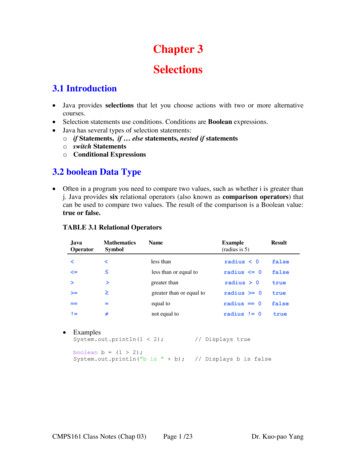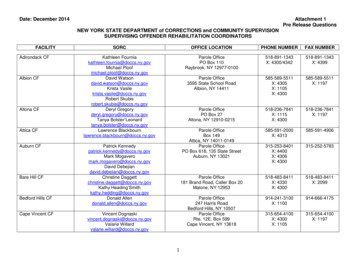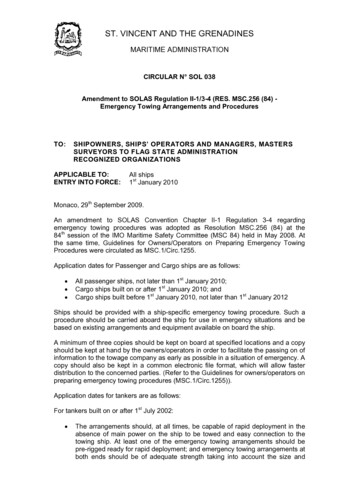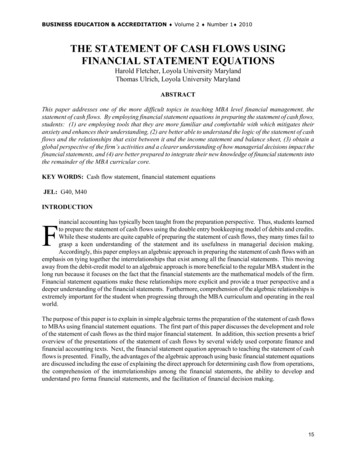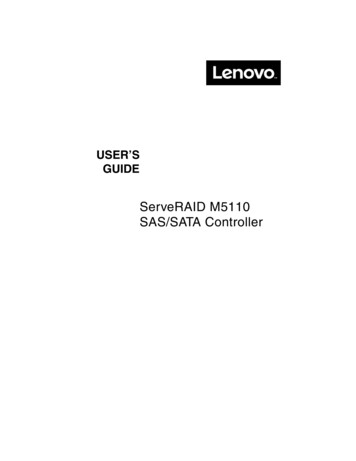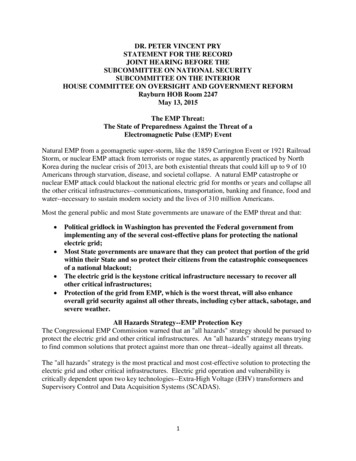
Transcription
DR. PETER VINCENT PRYSTATEMENT FOR THE RECORDJOINT HEARING BEFORE THESUBCOMMITTEE ON NATIONAL SECURITYSUBCOMMITTEE ON THE INTERIORHOUSE COMMITTEE ON OVERSIGHT AND GOVERNMENT REFORMRayburn HOB Room 2247May 13, 2015The EMP Threat:The State of Preparedness Against the Threat of aElectromagnetic Pulse (EMP) EventNatural EMP from a geomagnetic super-storm, like the 1859 Carrington Event or 1921 RailroadStorm, or nuclear EMP attack from terrorists or rogue states, as apparently practiced by NorthKorea during the nuclear crisis of 2013, are both existential threats that could kill up to 9 of 10Americans through starvation, disease, and societal collapse. A natural EMP catastrophe ornuclear EMP attack could blackout the national electric grid for months or years and collapse allthe other critical infrastructures--communications, transportation, banking and finance, food andwater--necessary to sustain modern society and the lives of 310 million Americans.Most the general public and most State governments are unaware of the EMP threat and that: Political gridlock in Washington has prevented the Federal government fromimplementing any of the several cost-effective plans for protecting the nationalelectric grid;Most State governments are unaware that they can protect that portion of the gridwithin their State and so protect their citizens from the catastrophic consequencesof a national blackout;The electric grid is the keystone critical infrastructure necessary to recover allother critical infrastructures;Protection of the grid from EMP, which is the worst threat, will also enhanceoverall grid security against all other threats, including cyber attack, sabotage, andsevere weather.All Hazards Strategy--EMP Protection KeyThe Congressional EMP Commission warned that an "all hazards" strategy should be pursued toprotect the electric grid and other critical infrastructures. An "all hazards" strategy means tryingto find common solutions that protect against more than one threat--ideally against all threats.The "all hazards" strategy is the most practical and most cost-effective solution to protecting theelectric grid and other critical infrastructures. Electric grid operation and vulnerability iscritically dependent upon two key technologies--Extra-High Voltage (EHV) transformers andSupervisory Control and Data Acquisition Systems (SCADAS).1
EHV TransformersEHV transformers are the technological foundation of our modern electronic civilization as theymake it possible to transmit electric power over great distances. An EHV transformer typicallyis as large as a house, weighs hundreds of tons, costs millions of dollars, and cannot be massproduced but must be custom-made by hand. Making a single EHV transformer takes about 18months. Annual worldwide production of EHV transformers is about 200 per year.Unfortunately, although Nikolai Tesla invented the EHV transformer and the electric grid in theU.S., EHV transformers are no longer manufactured in the United States. Because of their greatsize and cost, U.S. electric utilities have very few spare EHV transformers. The U.S. mustimport EHV transformers made in Germany or South Korea, the only two nations in the worldthat make them for export.An event that damages hundreds--or even as few as 9--of the 2,000 EHV transformers in theUnited States could plunge the nation into a protracted blackout lasting months or even years.SCADASSCADAS are basically small computers that run the electric grid and all the criticalinfrastructures. For example, SCADAS regulate the flow of electric current through EHVtransformers, the flow of natural gas or of water through pipelines, the flow of data throughcommunications and financial systems, and operate everything from traffic control lights to therefrigerators in regional food warehouses.SCADAS are ubiquitous in the civilian critical infrastructures, number in the millions, and are asindispensable as EHV transformers to running our modern electronic civilization.An event that damages large numbers of SCADAS would put that civilization at risk.Nuclear EMP--The Worst ThreatHigh-altitude nuclear EMP attack is the greatest single threat that could be posed to EHVtransformers, SCADAS and other components of the national electric grid and other criticalinfrastructures. Nuclear EMP includes a high-frequency electromagnetic shockwave called E1EMP that can potentially damage or destroy virtually any electronic system having a dimensionof 18 inches or greater.E1 EMP is unique to nuclear weapons.Consequently, a high-altitude nuclear EMP event could cause broad damage of electronics andcritical infrastructures across continental North America, while also causing deep damage toindustrial and personal property, including to automobiles and personal computers.Nuclear EMP can also produce E2 EMP, comparable to lightning.In contrast, natural EMP from a geomagnetic super-storm generates no E1 EMP, only E3 EMP(technically called magneto-hydrodynamic EMP, or E3 for short). E3 EMP has such longwavelengths that it requires a large "antennae" of about 1 kilometer or more in length, such as2
power lines, telephone lines, pipelines, and railroad tracks. E3 EMP cannot enter directlyrelatively small targets such as automobiles or personal computers.However, while a geomagnetic super-storm would not directly damage relatively smallelectronic systems, a protracted nationwide blackout resulting from such a storm would withindays stop everything. Personal computers cannot run for long on batteries, nor can automobilesrun without gasoline.Nuclear EMP can also produce E3 EMP comparable to or greater than a geomagnetic superstorm. Even a relatively low-yield nuclear weapon, like the 10-kiloton Hiroshima bomb, cangenerate an E3 EMP field powerful enough to damage EHV transformers.The Congressional EMP Commission recommended protecting the electric grid and other criticalinfrastructures against nuclear EMP as the best basis for an "all hazards" strategy. Nuclear EMPmay not be as likely as other threats, but it is by far the worst, the most severe, threat.The EMP Commission found that if the electric grid can be protected and quickly recoveredfrom nuclear EMP, the other critical infrastructures can also be recovered, with good planning,quickly enough to prevent mass starvation and restore society to normalcy. If EHV transformers,SCADAS and other critical components are protected from the worst threat--nuclear EMP--thenthey will survive, or damage will be greatly mitigated, from all lesser threats, including naturalEMP from geomagnetic storms, severe weather, sabotage, and cyber attack.The New "Lightning War"The "all hazards" strategy recommended by the EMP Commission is not only the most costeffective strategy--it is a necessary strategy. U.S. emergency planners tend to think of EMP,cyber, sabotage, severe weather, and geo-storms in isolation, as unrelated threatsHowever, potential foreign adversaries in their military doctrines and actual military operationsappear to be planning an offensive "all hazards" strategy that would throw at the U.S. electricgrid and civilian critical infrastructures--every possible threat simultaneouslyIran, North Korea, China and Russia appear to be perfecting what Moscow calls a "Revolutionin Military Affairs" that is potentially more decisive than Nazi Germany's Blitzkrieg ("LightningWar") strategy that nearly conquered the western democracies during World War II. The NewLightning War would attack the electric grid and other critical infrastructures--the technologicaland societal Achilles Heel of electronic civilization--with coordinated employment of cyber,sabotage, and EMP attacks, possibly timed to leverage severe space or terrestrial weather.While gridlock in Washington has prevented the Federal Government from protecting thenational electric power infrastructure, threats to the grid--and to the survival of the Americanpeople--from EMP and other hazards are looming ever larger. Grid vulnerability to EMP andother threats is now a clear and present danger.3
Geomagnetic StormsNatural EMP from geomagnetic storms, caused when a coronal mass ejection from the Suncollides with the Earth's magnetosphere, poses a significant threat to the electric grid and thecritical infrastructures, that all depend directly or indirectly upon electricity. Normalgeomagnetic storms occur every year causing problems with communications and electric gridsfor nations located at high northern latitudes, such as Norway, Sweden, Finland and Canada.For example, the 1989 Hydro-Quebec Storm blacked-out the eastern half of Canada in 92seconds, melted an EHV transformer at the Salem, New Jersey nuclear power plant, and causedbillions of dollars in economic losses.In 1921 a geomagnetic storm ten times more powerful, the Railroad Storm, afflicted the whole ofNorth America. It did not have catastrophic consequences because electrification of the U.S. andCanada was still in its infancy. The National Academy of Sciences estimates that if the 1921Railroad Storm recurs today, it would cause a catastrophic nationwide blackout lasting 4-10years and costing trillions of dollars.The Carrington EventThe most powerful geomagnetic storm ever recorded is the 1859 Carrington Event, estimated tobe ten times more powerful than the 1921 Railroad Storm and classed as a geomagnetic superstorm.Natural EMP from the Carrington Event penetrated miles deep into the Atlantic Ocean anddestroyed the just laid intercontinental telegraph cable. The Carrington Event was a worldwidephenomenon, causing fires in telegraph stations and forest fires from telegraph lines bursting intoflames on several continents. Fortunately, in the horse and buggy days of 1859, civilization didnot depend upon electrical systems.Recurrence of a Carrington Event today would collapse electric grids and critical infrastructuresall over the planet, putting at risk billions of lives. Scientists estimate that geomagnetic superstorms occur about every 100-150 years. The Earth is probably overdue to encounter anotherCarrington Event.NASA warns that on July 22, 2012, a powerful solar flare narrowly missed the Earth that wouldhave generated a geomagnetic super-storm, like the 1859 Carrington Event, and collapsedelectric grids and life sustaining critical infrastructures worldwide.The National Intelligence Council (NIC), that speaks for the entire U.S. Intelligence Community,published a major unclassified report in December 2012 Global Trends 2030 that warns ageomagnetic super-storm, like recurrence of the 1859 Carrington Event, is one of only eight"Black Swans" that could by or before 2030 change the course of global civilization. The NICconcurs with the consensus view that another Carrington Event could recur at any time, possiblybefore 2030, and that, if it did, electric grids and critical infrastructures that support moderncivilization could collapse worldwide.4
NASA estimates that the likelihood of a geomagnetic super-storm is 12 percent per decade. Thisvirtually guarantees that Earth will experience a natural EMP catastrophe in our lifetimes or thatof our children.NERC "Operational Procedures" Non-SolutionThe North American Electric Reliability Corporation (NERC), the lobby for the electric powerindustry that is also supposed to set industry standards for grid security, claims it can protect thegrid from geomagnetic super-storms by "operational procedures." Operational procedures wouldrely on satellite early warning of an impending Carrington Event to allow grid operators to shiftaround electric loads, perhaps deliberately brownout or blackout part or all of the grid in order tosave it. NERC estimates operational procedures would cost the electric utilities almost nothing,about 200,000 dollars annually.Critics rightly argue that NERC's proposed operational procedures is a non-solution designed asan excuse to avoid the expense of the only real solution--physically hardening the electric grid towithstand EMP.The ACE satellite is aged and sometimes gives false warnings that are not a reliable basis forimplementing operational procedures. While coronal mass ejections can be seen approachingEarth typically about three days before impact, the Carrington Event reached Earth in only 11hours, and the Ace satellite cannot warn whether a geo-storm will hit the Earth until merely 2030 minutes before impact.Most recently, on September 19-20, 2014, the National Oceanic and Atmospheric Administrationand NERC demonstrated again that they are unable to ascertain until shortly before impactwhether a coronal mass ejection will cause a threatening geomagnetic storm on Earth.There is no command and control system for coordinating operational procedures among the3,000 independent electric utilities in the United States. Operational procedures routinely fail toprevent blackouts from normal terrestrial weather, like snowstorms and hurricanes. There is nocredible basis for thinking that operational procedures alone would be able to cope with ageomagnetic super-storm--a threat unprecedented in the experience of NERC and the electricpower industry.NERC has not helped its case by being caught red handed peddling "junk science" that grosslyunderestimates the threat from another Carrington Event.States Should EMP Harden Their GridsNERC rejects the recommendation of the Congressional EMP Commission to physically protectthe national electric grid from nuclear EMP attack by installing blocking devices, surge arrestors,faraday cages and other proven technologies. These measures would also protect the grid fromthe worst natural EMP from a geomagnetic super-storm like another Carrington Event. Theestimated one time cost-- 2 billion dollars--is what the United States gives away every year inforeign aid to Pakistan.5
Yet Washington remains gridlocked between lobbying by NERC and the wealthy electric powerindustry on the one hand, and the recommendations of the Congressional EMP Commission andother independent scientific and strategic experts on the other hand. The States should not waitfor Washington to act, but should act now to protect themselves.Catastrophe from a geomagnetic super-storm may well happen sooner rather than later--andperhaps in combination with a nuclear EMP attack.Paul Stockton, President Obama's former Assistant Secretary of Defense for Homeland Defense,on June 30, 2014, at the Electric Infrastructure Security Summit in London, warned aninternational audience that an adversary might coordinate nuclear EMP attack with an impendingor ongoing geomagnetic storm to confuse the victim and maximize damage. Stockton notes that,historically, generals have often coordinated their military operations with the weather. Forexample, during World War II, General Dwight Eisenhower deliberately launched the D-Dayinvasion following a storm in the English Channel, correctly calculating that this daring actwould surprise Nazi Germany.Future military planners of the New Lightning War may well coordinate a nuclear EMP attackand other operations aimed at the electric grid and critical infrastructures with the ultimate spaceweather threat--a geomagnetic storm.Severe WeatherHurricanes, snow storms, heat waves and other severe weather poses an increasing threat to theincreasingly overtaxed, aged and fragile national electric grid. So far, the largest and mostprotracted blackouts in the United States have been caused by severe weather.For example, Hurricane Katrina (August 29, 2005), the worst natural disaster in U.S. history,blacked out New Orleans and much of Louisiana, the blackout seriously impeding rescue andrecovery efforts. Lawlessness swept the city. Electric power was not restored to parts of NewOrleans for months, making some neighborhoods a criminal no man's land too dangerous to livein. New Orleans has still not fully recovered its pre-Katrina population. Economic losses to theGulf States region totaled 108 billion dollars.Hurricane Sandy on October 29, 2012, caused blackouts in parts of New York and New Jerseythat in some places lasted weeks. Again, as in Katrina, the blackout gave rise to lawlessness andseriously impeded rescue and recovery. Thousands were rendered homeless in whole or in partbecause of the protracted blackout in some neighborhoods. Partial and temporary blackouts wereexperienced in 24 States. Total economic losses were 68 billion dollars.A heat-wave on August 14, 2003, caused a power line to sag into a tree branch, which seeminglyminor incident began a series of cascading failures that resulted in the Great Northeast Blackoutof 2003. Some 50 million Americans were without electric power--including New York City.Although the grid largely recovered after a day, disruption of the nation's financial capital wascostly, resulting in estimated economic losses of about 6 billion dollars.6
On September 18, 2014, a heat wave caused rolling brownouts and blackouts in northernCalifornia so severe that some radio commentators speculated that a terrorist attack on the gridmight be underway.NERC and Electric Utilities UnderperformIronically, about one week earlier, on September 8-10, 2014, there was a security conference onthreats to the national electric grid meeting in San Francisco. There executives from the electricpower industry credited themselves with building robust resilience into the electric power grid.They even congratulated themselves and their industry with exemplary performance coping withand recovering from blackouts caused by hurricanes and other natural disasters.The thousands of Americans left homeless due to Hurricanes Katrina and Sandy, the hundreds ofbusinesses lost or impoverished in New Orleans and New York City, would no doubt disagree.The U.S. Government Accountability Office (GAO), if it had jurisdiction to grade electric gridreliability during hurricanes, would almost certainly give the utilities a failing grade. Ever sinceHurricane Andrew in 1992, the U.S. GAO has found serious fault with efforts by the FederalEmergency Management Agency, the Department of Homeland Security, and the Department ofDefense to rescue and recover the American people from every major hurricane. Blackout of theelectric grid, of course, seriously impedes the capability of FEMA, DHS, and DOD to doanything.Since the utilities regulate themselves through the North American Electric ReliabilityCorporation, their uncritical view of their own performance reinforces a "do nothing" attitude inthe electric power industry.For example, after the Great Northeast Blackout of 2003, it took NERC a decade to propose anew "vegetation management plan" to protect the national grid from tree branches. NERC hasbeen even more resistant and slow to respond to other much more serious threats, includingcyber attack, sabotage, and natural EMP from geomagnetic storms.As noted earlier, NERC flatly rejects responsibility to protect the grid from nuclear EMP attack.New York and Massachusetts Protect Their GridsNew York Governor Andrew Cuomo and Massachusetts Governor Deval Patrick would notagree that NERC's performance during Hurricane Sandy was exemplary. Under the leadership ofGovernor Patrick, Massachusetts is spending 500 million to upgrade the security of its electricgrid from severe weather. New York is spending a billion dollars to protect its grid from severeweather.Unfortunately, both States are probably spending a lot more than they have to by focusing onsevere weather, instead of an "all hazards" strategy to protect their electric grids.The biggest impediment to recovering an electric grid from hurricanes is not fallen electric polesand downed power lines. When part of the grid physically collapses, an overvoltage can resultthat can damage all kinds of transformers, including EHV transformers, SCADAS and other vital7
grid components. Video footage shown on national television during Hurricane Sandy showedspectacular explosions and fires erupting from transformers and other grid vital componentscaused by overvoltage.If the grid is hardened to survive a nuclear EMP attack by installation of surge arrestors, it wouldeasily survive overvoltage induced by hurricanes and other severe weather. This would cost a lotless than burying power lines underground and other measures being undertaken by New Yorkand Massachusetts to fortify their grids against hurricanes--all of which will be futile iftransformers and SCADAS are not protected against overvoltage.According to a senior executive of New York's Consolidated Edison, briefing at the ElectricInfrastructure Security Summit in London on July 1, 2014--Con Ed is taking some modest stepsto protect part of the New York electric grid from nuclear EMP attack. This good news has notbeen reported anywhere in the press.I asked the Con Ed executive why New York is silent about beginning to protect its grid fromnuclear EMP? Loudly advertising this prudent step could have a deterrent effect on potentialadversaries planning an EMP attack.The Con Ed executive could offer no explanation.New York City because of its symbolism as the financial and cultural capitol of the Free World,and perhaps because of its large Jewish population, has been the repeated target of terroristattacks with weapons of mass destruction. A nuclear EMP attack centered over New York City,the warhead detonated at an altitude of 30 kilometers, would cover all the northeastern UnitedStates with an EMP field, including Massachusetts.A practitioner of the New Lightning War may be more likely to exploit a hurricane, blizzard, orheat wave than a geomagnetic storm, when launching a coordinated cyber, sabotage, and EMPattack. Terrestrial bad weather is more commonplace than bad space weather.New York and Massachusetts have both been frontline States in the war on terrorism. NuclearEMP attack could potentially put in the frontlines--and in the crosshairs of a New LightningWar--all the States.All the States should prepare themselves for all hazards in this age of the Electronic Blitzkrieg.Sabotage--Kinetic AttacksKinetic attacks are a serious threat to the electric grid and are clearly part of the game plan forterrorists and rogue states. Sabotage of the electric grid is perhaps the easiest operation for aterrorist group to execute and would be perhaps the most cost-effective means, requiring onlyhigh-powered rifles, for a very small number of bad actors to wage asymmetric warfare--perhapsagainst all 310 million Americans.Terrorists have figured out that the electric grid is a major societal vulnerability.8
Terror Blackout in MexicoOn the morning of October 27, 2013, the Knights Templars, a terrorist drug cartel in Mexico,attacked a big part of the Mexican grid, using small arms and bombs to blast electric substations.They blacked-out the entire Mexican state of Mihoacan, plunging 420,000 people into the dark,isolating them from help from the Federales. The Knights went into towns and villages andpublicly executed local leaders opposed to the drug trade.Ironically, that evening in the United States, the National Geographic aired a televisiondocudrama "American Blackout" that accurately portrayed the catastrophic consequences of acyber attack that blacks-out the U.S. grid for ten days. The North American Electric ReliabilityCorporation and some utilities criticized "American Blackout" for being alarmist and unrealistic,apparently unaware that life had already anticipated art just across the porous border in Mexico.Life had already anticipated art months earlier than "American Blackout", and not in Mexico, butin the United States.The Metcalf AttackOn April 16, 2013, apparently terrorists or professional saboteurs practiced making an attack onthe Metcalf transformer substation outside San Jose, California, that services a 450 megawattpower plant providing electricity to the Silicon Valley and the San Francisco area. NERC andthe utility Pacific Gas and Electric (PG&E), that owns Metcalf, claimed that the incident wasmerely an act of vandalism, and discouraged press interest.Consequently, the national press paid nearly no attention to the Metcalf affair for nine months.Jon Wellinghoff, Chairman of the U.S. Federal Energy Regulatory Commission, conducted anindependent investigation of Metcalf. He brought in the best of the best of U.S. special forces-the instructors who train the U.S. Navy SEALS. They concluded that the attack on Metcalf wasa highly professional military operation, comparable to what the SEALS themselves would dowhen attacking a power grid.Footprints suggested that a team of perhaps as many as six men executed the Metcalf operation.They knew about an underground communications tunnel at Metcalf and knew how to access itby removing a manhole cover (which required at least two men). They cut communicationscables and the 911 cable to isolate the site. They had pre-surveyed firing positions. They usedAK-47s, the favorite assault rifle of terrorists and rogue states. They knew precisely where toshoot to maximize damage to the 17 transformers at Metcalf. They escaped into the night just asthe police arrived and have not been apprehended or even identified. They left no fingerprintsanywhere, not even on the expended shell casings.The Metcalf assailants only damaged but did not destroy the transformers--apparentlydeliberately. The Navy SEALS and U.S. FERC Chairman Wellinghoff concluded that theMetcalf operation was a "dry run", like a military exercise, practice for a larger and moreambitious attack on the grid to be executed in the future.9
Military exercises never try to destroy the enemy, and try to keep a low profile so that thepotential victim is not moved to reinforce his defenses. For example, Russian strategic bomberexercises only send a few aircraft to probe U.S. air defenses in Alaska, and never actually launchnuclear-armed cruise missiles. They want to probe and test our air defenses--not scare us intostrengthening those defenses.Chairman Wellinghoff was aware of an internal study by U.S. FERC that concluded saboteurscould blackout the national electric grid for weeks or months by destroying just nine crucialtransformer substations.Much to his credit, Jon Wellinghoff became so alarmed by his knowledge of U.S. gridvulnerability, and the apparent NERC cover-up of the Metcalf affair, that he resigned hischairmanship to warn the American people in a story published by the Wall Street Journal inFebruary 2014. The Metcalf story sparked a firestorm of interest in the press and investigationsby Congress.Consequently, NERC passed, on an emergency basis, a new standard for immediately upgradingphysical security for the national electric grid. PG&E promised to spend over 100 million overthe next three years to upgrade physical security.Terror Blackout of YemenOn June 9, 2014, while world media attention was focused on the terror group Islamic State inIraq and Syria (ISIS) overrunning northern Iraq, Al Qaeda in the Arabian Peninsula (AQAP)used mortars and rockets to destroy electric transmission towers to blackout all of Yemen, anation of 16 cities and 24 million people.AQAP's operation against the Yemen electric grid is the first time in history that terrorists havesunk an entire nation into blackout. The blackout went virtually unreported by the world press.Metcalf Again--NERC and Utilities NegligentTwo months later, amid growing fears that ISIS may somehow act on its threats to attackAmerica, on August 27, 2014, parties unknown again broke into the Metcalf transformersubstation and escaped PG&E security guards and the police. PG&E claims that the secondMetcalf affair is, again, merely vandalism.Yet after NERC's emergency new physical security standards and PG&E's alleged massiveinvestment in improved security--Metcalf should have been the Rock of Gibraltar of the NorthAmerican electric grid. If terrorists or someone is planning an attack on the U.S. electric grid,Metcalf would be the perfect place to test the supposedly strengthened security of the nationalgrid.Does stolen equipment prove that Metcalf-2 was a burglary? In the world of spies and saboteurs,mock burglary is a commonplace device for covering-up an intelligence operation, and hopefullyquelling fears and keeping the victim unprepared.10
If PG&E is telling the truth, and the second successful operation against Metcalf is merely byvandals--this is an engraved invitation by ISIS or Al Qaeda or rogue states to attack the U.S.electric grid. It means that all of PG&E and NERC's vaunted security improvements cannotprotect Metcalf from the stupidest of criminals, let alone from terrorists.About one month later, on September 23, 2014, another investigation of PG&E security attransformer substations, including Metcalf, reported that the transformer substations are still notsecure. Indeed, at one site a gate was left wide open. Former CIA Director R. James Woolsey,after reviewing the investigation results, concluded, "Overall, it looks like there is essentially nosecurity."States Should EMP Harden Their GridsState governments and their Public Utility Commissions should exercise aggressive oversight toensure that the transformer substations and electric grids in their States are safe and secure. Therecord of NERC and the electric utilities indicates they cannot be trusted to provide for thesecurity of the grid.State governments can protect their grid from sabotage by the "all hazards" strategy that protectsagainst the worst threat--nuclear EMP attack.For example, faraday cages to protect EHV transformers and SCADAS colonies from EMPwould also screen from view these vital assets so they could not be accurately targeted by highpowered rifles, as is necessary in order to destroy them by small arms fire. The faraday cagescould be made of heavy metal or otherwise fortified for more robust protection against morepowerful weapons, like rocket propelled grenades.Surge arrestors to protect EHV transformers and
overall grid security against all other threats, including cyber attack, sabotage, and severe weather. All Hazards Strategy--EMP Protection Key The Congressional EMP Commission warned that an "all hazards" strategy should be pursued to protect the electric grid and other critical infrastructures. An "all hazards" strategy means trying

